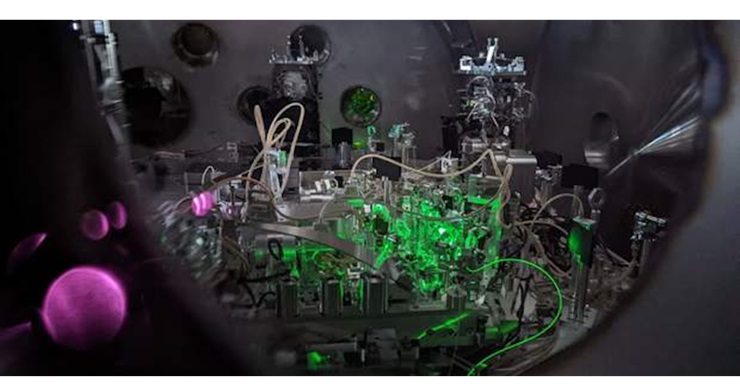Harnessing Quantum Squeezing | A Leap Forward in Gravitational-Wave Astronomy | How Frequency-Dependent Squeezing is Quieting Quantum Noise and Expanding Our Cosmic Horizons
 Gravitational-wave astronomy has entered an exciting new phase, one where the subtle ripples in spacetime are now even more within our grasp. At the heart of this revolution is the LIGO Scientific Collaboration’s innovative noise-squeezing technique. This method has redefined the sensitivity of gravitational-wave detectors by mitigating the quantum noise that once obscured the faint signals of cataclysmic cosmic events. By meticulously adjusting the quantum state of light, researchers have created an opportunity to peer deeper into the Universe, potentially expanding our observable volume by up to 65%.
Gravitational-wave astronomy has entered an exciting new phase, one where the subtle ripples in spacetime are now even more within our grasp. At the heart of this revolution is the LIGO Scientific Collaboration’s innovative noise-squeezing technique. This method has redefined the sensitivity of gravitational-wave detectors by mitigating the quantum noise that once obscured the faint signals of cataclysmic cosmic events. By meticulously adjusting the quantum state of light, researchers have created an opportunity to peer deeper into the Universe, potentially expanding our observable volume by up to 65%.
The challenge stems from the very nature of the quantum realm. Gravitational-wave detectors like LIGO are engineered to sense distortions in spacetime that are smaller than a proton’s diameter. Yet at these extremes, quantum fluctuations—temporary changes in energy that produce fleeting particles and photons—imprint a “crackle” on the measurements. This noise is best visualized as an ellipse, where uncertainties in the amplitude and phase of light create a trade-off defined by Heisenberg’s uncertainty principle. Overcoming this obstacle has been crucial for advancing our capacity to detect and study gravitational waves.
Enter the innovative strategy of frequency-dependent squeezing. Traditionally, noise reduction efforts focused on squeezing one aspect of the noise ellipse, typically the phase noise, which worked well for high-frequency signals. However, this approach left low-frequency regions vulnerable to amplitude noise, notably from the radiation pressure exerted by photons. By employing a 300-meter-long filter cavity, the LIGO team has successfully tailored the squeezing—applying amplitude squeezing at lower frequencies and phase squeezing at higher frequencies. This frequency-dependent technique elegantly addresses the distinct challenges across the entire spectrum of detectable gravitational-wave frequencies.
The benefits of this breakthrough are profound. In rigorous tests, frequency-dependent squeezing not only maintained the enhancements achieved at high frequencies but also significantly reduced the detrimental low-frequency noise. This improvement means that LIGO can now detect mergers of compact objects, such as black holes and neutron stars, with far greater fidelity. As a result, the enhanced sensitivity is projected to increase the distance over which these cosmic collisions can be observed by 15%–18%, effectively probing a 65% larger volume of the Universe. Such gains promise to enrich our understanding of cosmic phenomena and challenge the boundaries of general relativity.
The journey to achieving this milestone was not without its engineering challenges. Integrating a 300-meter filter cavity into the existing detector infrastructure required unprecedented precision. The process demanded a thorough minimization of optical losses—imperfections that could allow non-squeezed vacuum noise to seep back into the system. This rigorous approach has not only refined the current generation of detectors but also laid a robust foundation for future enhancements in gravitational-wave technology, ensuring that every photon counts in our quest to unlock the Universe’s secrets.
Looking forward, this advancement heralds a new era for next-generation gravitational-wave observatories, including ambitious projects like the Cosmic Explorer and the Einstein Telescope. These future instruments aim for an even more dramatic leap—a tenfold increase in noise-squeezing power. As researchers continue to push the frontiers of quantum optics and interferometry, the innovations pioneered by the LIGO team offer a promising blueprint. They illustrate how mastering quantum measurement theory on kilometer scales can yield transformative insights into the cosmos.
Ultimately, the improved sensitivity of gravitational-wave detectors is not just a technical achievement—it is a profound stride towards understanding the Universe at its most fundamental level. For scientists and enthusiasts alike, these developments open the door to a richer catalogue of cosmic events, enabling the exploration of previously unseen gravitational waves and deepening our grasp of the forces that shape our reality. As our instruments become ever more refined, so too does our ability to listen to the subtle symphony of the cosmos, where every merger, every ripple, tells a story of cosmic evolution and the underlying laws of physics.
Key Takeaways:
- Enhanced Sensitivity: Frequency-dependent squeezing dramatically reduces quantum noise, allowing detectors to capture fainter gravitational-wave signals.
- Expanded Cosmic Reach: With a potential 65% increase in the observable volume of the Universe, our window into cosmic events is significantly broadened.
- Future-Forward Technology: This breakthrough paves the way for next-generation observatories, promising even deeper insights into the fabric of spacetime.
“The LIGO Scientific Collaboration has demonstrated a noise-squeezing technique for the entire range of gravitational frequencies LIGO can detect—a feat that could boost the detection rate of black hole mergers by up to 65%.”
Explore these cutting-edge advancements further on SpeciesUniverse.com, and join us as we delve deeper into the mysteries of the cosmos. Discover related articles, engage with our community of passionate researchers, and stay informed about the latest breakthroughs in gravitational-wave astronomy. Your journey into the heart of the Universe is just beginning!
More details: here

Leave a Reply